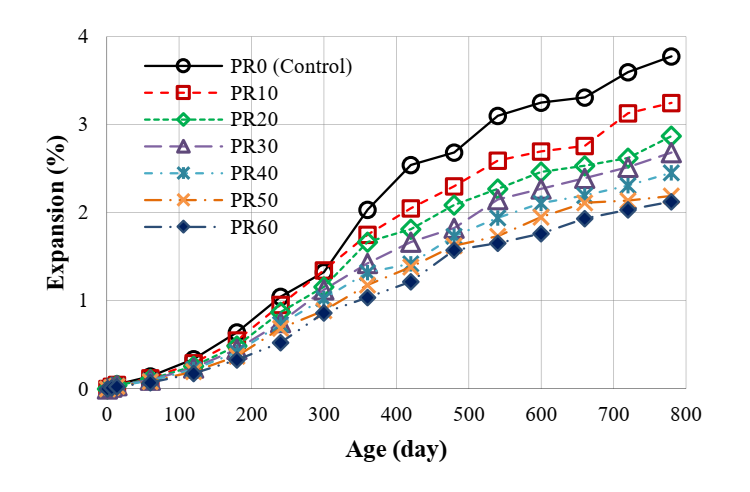Prediction of Expansion due to Sulfate of Ground Bottom Ash Mortar by an Artificial Neural Network
Keywords:
prediction, expansion of mortar, ground bottom ash, sulfate, Artificial Neural NetworkAbstract
This paper presents the application of the artificial neural network model (ANN) to predict the expansion of ground bottom ash mortar due to sodium sulfate. Portland cement type I was replaced by ground bottom ash at ratios of 0, 10, 20, 30, 40, 50 and 60 percent by weight of binder. The expansion of mortar which immersed in 5% sodium sulfate at various ages was measured. To show the efficiency of the proposed model, the prediction results of the ANN model are compared with the multiple linear regression (MLR) and the multiple second order polynomial regression (MSPR) models through statistical values. From the prediction results, it was found that the ANN model has a very high expansion prediction accuracy and more effective than the MLR and MSPR. The ANN model has a statistical value of absolute variance higher than 0.99. Therefore, it is concluded that the ANN model has a strong prediction capability of expansion due to sulfate of ground bottom ash mortar.
References
S.C. Lee, "Prediction of concrete strength using artificial neural networks," Engineering structures, vol. 25, no. 7, pp. 849-857, 2003.
C.-J. Lin and N.-J. Wu, "An ANN model for predicting the compressive strength of concrete," Applied Sciences, vol. 11, no. 9, p. 3798, 2021.
K. Tuntisukrarom and R. Cheerarot, "Prediction of compressive strength behavior of ground bottom ash concrete by an artificial neural network," Advances in materials science and engineering, vol. 2020, pp. 1-16, 2020.
A. Q. Khan, H. A. Awan, M. Rasul, Z. A. Siddiqi, and A. Pimanmas, "Optimized artificial neural network model for accurate prediction of compressive strength of normal and high strength concrete," Cleaner Materials, vol. 10, p. 100211, 2023.
K. Vellaipandian, R. P. Periasamy, and V. Balasubramanian, "Prediction and validation of constituent materials for concrete manufacturing using artificial neural network," Innovative Infrastructure Solutions, vol. 8, no. 6, p. 160, 2023.
İ. B. Topçu and M. Sarıdemir, "Prediction of mechanical properties of recycled aggregate concretes containing silica fume using artificial neural networks and fuzzy logic," Computational Materials Science, vol. 42, no. 1, pp. 74-82, 2008.
P. Yu, H. Qiu, S. He, Y. Qin, and Y. Zhou, "Pore structure and prediction of mechanical properties by ANN of concrete mixed MK and SF under hydrochloric acid corrosion," Construction and Building Materials, vol. 409, p. 133665, 2023.
O. Mohamed, M. Kewalramani, M. Ati, and W. Al Hawat, "Application of ANN for prediction of chloride penetration resistance and concrete compressive strength," Materialia, vol. 17, p. 101123, 2021.
S. Sahoo and T. R. Mahapatra, "ANN Modeling to study strength loss of Fly Ash Concrete against Long term Sulphate Attack," Materials Today: Proceedings, vol. 5, no. 11, pp. 24595-24604, 2018.
S. Inthata, W. Kowtanapanich, and R. Cheerarot, "Prediction of chloride permeability of concretes containing ground pozzolans by artificial neural networks," Materials and structures, vol. 46, pp. 1707-1721, 2013.
J. A. Becerra-Duitama and D. Rojas-Avellaneda, "Pozzolans: A review," Engineering & Applied Science Research, vol. 49, no. 4, 2022.
U. Chaisakulkiet, N. Makaratat, and S. Rukzon, "Development of aggregate from bottom ash in environmentally friendly concrete," Journal of Metals, Materials and Minerals, vol. 32, no. 2, pp. 101-108, 2022.
A. Abdulmatin, W. Tangchirapat, and C. Jaturapitakkul, "An investigation of bottom ash as a pozzolanic material," Construction and Building Materials, vol. 186, pp. 155-162, 2018.
B. González-Fonteboa, D. Carro-López, J. de Brito, F. Martínez-Abella, S. Seara-Paz, and S. Gutiérrez-Mainar, "Comparison of ground bottom ash and limestone as additions in blended cements," Materials and Structures, vol. 50, pp. 1-13, 2017.
A. Abdulmatin, P. S. Khongpermgoson, S. Sanit-in, C. Jaturapitakkul, W. Tangchirapat, N. Khomwan, and T. M. Pham, "Bottom ash as an alternative pozzolanic material to produce eco-friendly, high-quality chloride-resistant concrete," Iranian Journal of Science and Technology, Transactions of Civil Engineering, vol. 47, no. 2, pp. 829-842, 2023.
C. Jaturapitakkul and R. Cheerarot, "Development of bottom ash as pozzolanic material," Journal of materials in civil engineering, vol. 15, no. 1, pp. 48-53, 2003.
S. Tangtermsirikul, "Use of bottom ash in concrete," Eng. Tech. Conference and Exhibition, Bangkok, Thailand, 2002, pp. 169-177.
N. Ghafoori and Y. Cai, "Laboratory-made roller compacted concretes containing dry bottom ash: Part ii—long-term durability," Materials Journal, vol. 95, no. 3, pp. 244-251, 1998.
N. Ghafoori and J. Bucholc, "Investigation of lignite-based bottom ash for structural concrete," Journal of Materials in Civil Engineering, vol. 8, no. 3, pp. 128-137, 1996.
N. Ghafoori and J. Buchole, "Properties of high-calcium dry bottom ash for structural concrete," Materials Journal, vol. 94, no. 2, pp. 90-101, 1997.
M. Cheriaf, J. C. Rocha, and J. Pera, "Pozzolanic properties of pulverized coal combustion bottom ash," Cement and concrete research, vol. 29, no. 9, pp. 1387-1391, 1999.
S. Charhate, M. Subhedar, and N. Adsul, "Prediction of concrete properties using multiple linear regression and artificial neural network," Journal of Soft Computing in Civil Engineering, vol. 2, no. 3, pp. 27-38, 2018.
F. Khademi, S. M. Jamal, N. Deshpande, and S. Londhe, "Predicting strength of recycled aggregate concrete using artificial neural network, adaptive neuro-fuzzy inference system and multiple linear regression," International Journal of Sustainable Built Environment, vol. 5, no. 2, pp. 355-369, 2016.
F. Khademi, M. Akbari, S. M. Jamal, and M. Nikoo, "Multiple linear regression, artificial neural network, and fuzzy logic prediction of 28 days compressive strength of concrete," Frontiers of Structural and Civil Engineering, vol. 11, pp. 90-99, 2017.
F. Khademi and K. Behfarnia, "Evaluation of concrete compressive strength using artificial neural network and multiple linear regression models," Int. J. Optim. Civil Eng, vol. 6, no. 3, pp. 423-432, 2016.
H. H. Almasaeid and D. G. Salman, "Application of artificial neural network to predict the properties of permeable concrete," Civil Engineering and Architecture, vol. 10, no. 6, pp. 2290-2305, 2022.

Downloads
Published
How to Cite
Issue
Section
License

This work is licensed under a Creative Commons Attribution-NonCommercial-NoDerivatives 4.0 International License.








